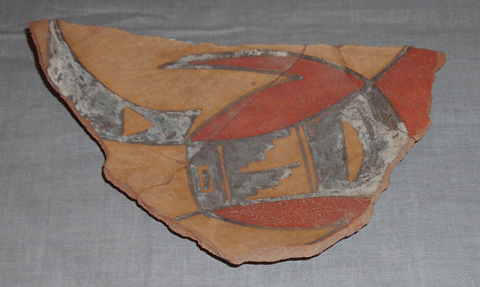
Pottery Mound
Encyclopedia
Pottery Mound was a late prehistoric village on the bank of the Rio Puerco, west of Los Lunas, New Mexico
. It was an adobe pueblo most likely occupied between 1350 and 1500. The site is best known for its 17 kivas, which yielded a large number of murals. A 2007 book, New Perspectives on Pottery Mound Pueblo (Polly Schaafsma
2007) provides a general introduction to the site.
(UNM) directed archaeological field schools at the site in 1954 (Ballagh and Phillips 2006), 1955, 1957, and 1958. He also directed a research project funded by the National Science Foundation in 1960–1961 and afterwards led "salvage" digs conducted by volunteers, as late as the 1980s. In 1979, UNM anthropology professor Linda Cordell directed a surface sampling, mapping, and testing program at the site. In 2003 UNM, which now owns the site, began an effort to reorganize the site collections and publish detailed accounts of the fieldwork.
 Pottery Mound is named after the large number of potsherds
Pottery Mound is named after the large number of potsherds
lying on the site surface, and after its low mound of melted adobe
. The site was part of the Rio Grande Glaze Ware
tradition that began ca. 1315 and continued until the time of the Spanish reconquest of New Mexico in 1693. The site's signature pottery, Pottery Mound Polychrome, includes red and black paint on a background consisting of two slip colors (on bowls, one slip color on the inside and the other on the outside). As is typical in the southern part of the glaze ware production area, Glaze A pottery (simple rim forms) predominates (Franklin 2007).
Pottery Mound has the greatest variety of pottery of any prehistoric site in central New Mexico. Imported pottery includes Hopi decorated and plain wares, white paste wares from the Acoma-Zuni region of west-central New Mexico, and biscuit wares from north-central New Mexico (Franklin 2007).
Los Lunas, New Mexico
-2010:Whereas according to the 2010 U.S. Census Bureau:*72.1% White*2.0% Black*2.5% Native American*0.8% Asian*0.1% Native Hawaiian or Pacific Islander*4.2% Two or more races*18.3% Other races*57.9% Hispanic or Latino -2000:...
. It was an adobe pueblo most likely occupied between 1350 and 1500. The site is best known for its 17 kivas, which yielded a large number of murals. A 2007 book, New Perspectives on Pottery Mound Pueblo (Polly Schaafsma
Polly Schaafsma
Polly Dix Schaafsma is an American archaeologist, best known for her publications on Native American rock art. Dr. Schaafsma is a research associate in the Laboratory of Anthropology, Museum of New Mexico, Santa Fe, New Mexico. She and her husband, anthropologist Curtis F...
2007) provides a general introduction to the site.
Research History
Frank Hibben, a professor at the University of New MexicoUniversity of New Mexico
The University of New Mexico at Albuquerque is a public research university located in Albuquerque, New Mexico, in the United States. It is the state's flagship research institution...
(UNM) directed archaeological field schools at the site in 1954 (Ballagh and Phillips 2006), 1955, 1957, and 1958. He also directed a research project funded by the National Science Foundation in 1960–1961 and afterwards led "salvage" digs conducted by volunteers, as late as the 1980s. In 1979, UNM anthropology professor Linda Cordell directed a surface sampling, mapping, and testing program at the site. In 2003 UNM, which now owns the site, began an effort to reorganize the site collections and publish detailed accounts of the fieldwork.
Pottery

Sherd
In archaeology, a sherd is commonly a historic or prehistoric fragment of pottery, although the term is occasionally used to refer to fragments of stone and glass vessels as well....
lying on the site surface, and after its low mound of melted adobe
Adobe
Adobe is a natural building material made from sand, clay, water, and some kind of fibrous or organic material , which the builders shape into bricks using frames and dry in the sun. Adobe buildings are similar to cob and mudbrick buildings. Adobe structures are extremely durable, and account for...
. The site was part of the Rio Grande Glaze Ware
Rio Grande Glaze Ware
Rio Grande Glaze Ware is a late prehistoric and historic pottery tradition of the Puebloan peoples of New Mexico. The tradition involved painting pots with black paint made with lead ore; as the pots were fired the black paint fused and sometimes ran. The tradition lasted from AD 1315 to 1700...
tradition that began ca. 1315 and continued until the time of the Spanish reconquest of New Mexico in 1693. The site's signature pottery, Pottery Mound Polychrome, includes red and black paint on a background consisting of two slip colors (on bowls, one slip color on the inside and the other on the outside). As is typical in the southern part of the glaze ware production area, Glaze A pottery (simple rim forms) predominates (Franklin 2007).
Pottery Mound has the greatest variety of pottery of any prehistoric site in central New Mexico. Imported pottery includes Hopi decorated and plain wares, white paste wares from the Acoma-Zuni region of west-central New Mexico, and biscuit wares from north-central New Mexico (Franklin 2007).

